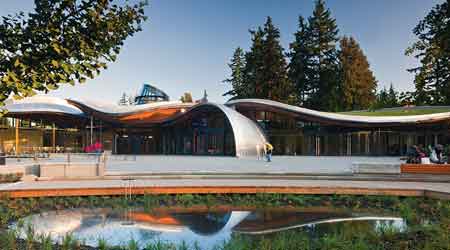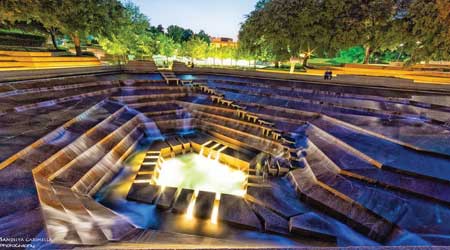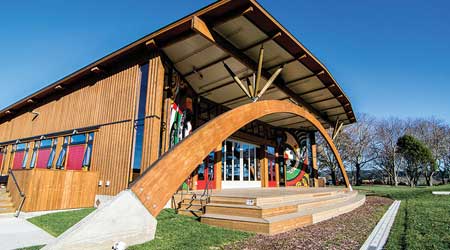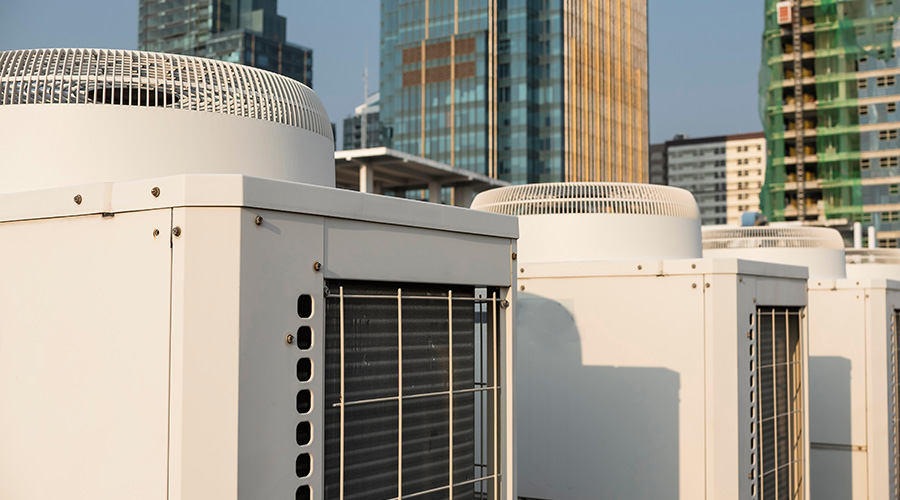 The shape of the VanDusen Botanical Garden Visitor Centre in Vancouver is inspired by the shape of a flower. Undulating vegetated roof “petals” seem to float above glass windows and curving walls made from rammed earth and concrete.Sharp & Diamond
The shape of the VanDusen Botanical Garden Visitor Centre in Vancouver is inspired by the shape of a flower. Undulating vegetated roof “petals” seem to float above glass windows and curving walls made from rammed earth and concrete.Sharp & Diamond Beyond Biophilic Design: How to Operate Natural Buildings
When biophilic design decisions are being made, facilities managers should be at the table to ensure the vision endures throughout the building’s life cycle.
Take a moment to relax, close your eyes, and picture a place that makes you feel serene. Where is this place? What can you see, hear, and feel?
If you found yourself in nature, then you just experienced a decrease in your stress and anxiety levels. Studies have shown that whether you are experiencing nature first-hand, in virtual reality, or through sounds and photos, you are proven to become happier, healthier, and more focused. For example, living on a city block with just ten more trees has the same health benefits as getting a $10,000 dollar raise or being seven years younger, according to a 2015 study published in Scientific Reports.
Nature isn’t just good for you — it’s good for the bottom line. The built environments that we work in have a huge impact on our health, focus, and mood, which directly translates to company profit. Adding natural elements to the built environment, like access to plants and sunlight, has an estimated return of $2,000 per employee per year. With human resources accounting for 90 percent of company budget on average, it is no wonder that some of the world’s top companies are investing in biophilic buildings.
Nature-based design has already been linked to myriad productivity outcomes including better sleep, increased job satisfaction, and greater creativity; all things that employees and employers are vying for. In fact, in a recent global study, 33 percent of respondents said that the design of an office would affect their decision to work there. So why do nearly half of employees report having no plants or natural light in their space? Companies like Google and Microsoft are planning to change that. By leading the charge and partnering with research organizations to study the effects of biophilic design in their offices, they are out to prove that nature has a serious return on investment.
What is biophilic design?
Biophilic design is derived from the term biophilia, which describes humans’ innate connection and affinity towards the natural world. Coined by biologist E.O. Wilson in 1984, the term reflects a response to humans’ blatant disconnect from the natural world paralleling rapid technological advancement. Densely constructed and engineered environments, dominated by hard surface, high-rise buildings and technology have only been prevalent for less than 0.2 percent of the human timeline.
Biophilic design brings us back to our roots, meaning that not only is it better for us, but it’s better for nature too. Increased exposure to natural elements reminds us of how inextricably connected we are to the earth and makes us better stewards of the environment.
So what can you do to make your building greener, your occupants healthier, and the world better? While there is no one-size-fits-all approach to biophilia, the importance of biophilic design has been widely recognized by research-based green building frameworks and incorporated into standards such as LEED, Living Building Challenge, and WELL, providing paths for integrating biophilia into your building.
Terrapin Bright Green’s 14 Patterns of Biophilic Design groups biophilic design strategies into three main categories: nature in the space, nature analogues, and nature of the space. Each of the 14 patterns are backed up by meticulous scientific studies that prove their worth. These can serve as a great starting point for facility managers, architects, building owners, and forward-thinking employees who want to bring nature into their place of work.
1. Nature in the space is the strategy most commonly associated with biophilia and involves incorporating elements of nature directly into buildings. This can include plants and animals, sunlight, fresh air, views of nature, natural sounds, and use of natural materials like wood and stone. This can also involve more unexpected techniques, like subtle variations in temperature and airflow, which have been shown to increase alertness.
2. Nature analogues are non-natural elements that evoke natural shapes, patterns, and sensory experiences. These can be as simple as a small mural, as subtle as dappled lighting, or as complex as the VanDusen Visitor’s Centre, a building inspired by the shape of a flower.
3. Nature of the space is focused on creating spaces that mimic our natural environment, without necessarily directly incorporating it. This means creating places of refuge, places of observation, or even places of perceived risk, like the unfenced water gardens at Fort Worth. By creating a variety of environments in which people can choose to work, rest, and meet, you give them back their freedom and sense of choice.

Caption: The Fort Worth Water Gardens, adjacent to the Fort Worth Convention Center, is a relaxing urban park offering conventioneers a place of refuge to relax. Photo credit: Visit Fort Worth
Additional common strategies used to achieve biophilic design are increasing access to outdoor spaces and implementing place-based design. While access to outdoor space can be achieved through simple, straightforward adjustment, the place-based design concept requires a more tailored approach. Place-based design takes inspiration from local culture, history, and motifs to create buildings that are grounded in their local communities. One example is Te Kura Whare Tuhoe in New Zealand, which was built to restore pride in the Tuhoe culture and bring people back to the land. It uses local materials and a grand arch that symbolizes the rising sun, action, and progress. Speak with local historians, community members, or artists to gain some inspiration on how to bring a sense of place to your building.

Caption: Te Kura Whare, in Taneatua, New Zealand, was created with the intention of restoring pride in the Tuhoe culture and the people’s inherent connection to the land. The building uses natural materials, and sense of place is expressed through many of the building’s features. For example, the timber comes from dead and downed native trees within Tuhoe Rohe to reflect the Tuhoe’s strong relationship with the forest. Further, the arch symbolizes the rising sun, representing action and progress to this indigenous culture.
It is clear that biophilic design can be incorporated into just about every aspect of a building, from its form to its finishes to its daily operations. That’s why the International Living Future Institute’s Biophilic Design Guidebook recommends running stakeholder workshops throughout a project’s design phase in order to establish a personalized biophilic design framework that suits all parties involved. Just like an ecosystem, biophilic design requires an integrated approach to building. At the end of this process, make sure to capture the project objectives and strategies in a comprehensive close out document or operations manual that can be referenced throughout the building lifecycle.
Related Topics:















